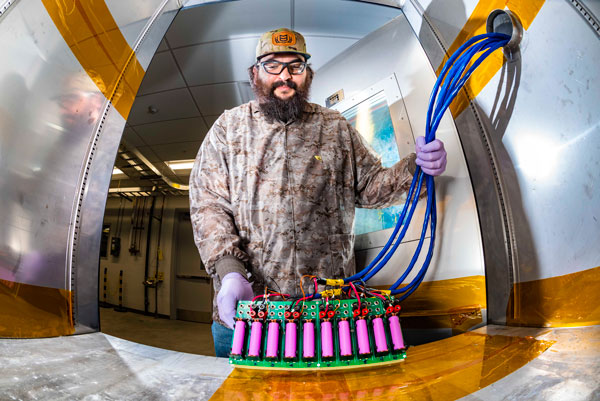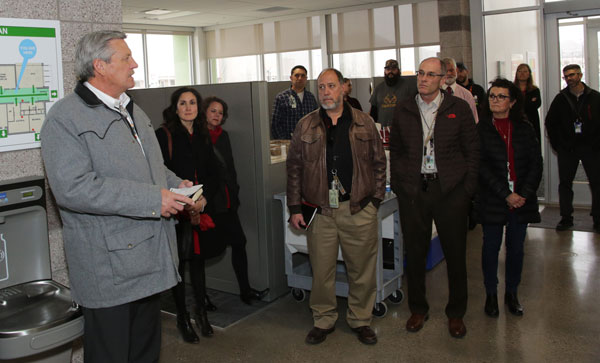
When Sandia tests the performance of high-capacity energy storage devices, the power sources group frequently would hit obstacles that reduced efficiencies and stretched out schedules.
Those obstacles have now been removed with the construction of a 7,500 square-foot Battery Test Facility that enables the team to assemble and test batteries more efficiently for customers to validate whether they perform up to expectations.
The new building was specifically designed to handle the tests. The team now can do higher-capacity battery testing for nuclear deterrence, security, grid storage and vehicle transportation.
“The Battery Test Facility allows us to take on more work, especially in the national security space,” said Chris Orendorff, senior manager. “In terms of different capabilities, it will allow for performance testing of a variety of battery systems of different chemistries in relevant sizes for our customers.”
The facility represents the first stage in consolidating all of Sandia’s battery-testing activities. It provides more of the environmental and risk controls needed to conduct performance testing successfully.
“High precision testing was difficult because it was hard to control the temperature adequately in the old building,” said Daena Richter, who led operations for the construction project.
Previously, testing complications sometimes led to facility failures that interfered with work others did in the building, so some higher-risk experiments had to be conducted at remote sites.
“It took a lot of logistics, time and planning to use these other facilities as the former building couldn’t handle these higher-risk activities,” Daena said.
Designers built engineered controls into the Battery Test Facility to avoid such risks. Features include concrete masonry infrastructure, gas sensor equipment, work stations outside the labs so technicians can conduct tests remotely and two specially designed hazardous materials storage units, as well as local exhaust ventilation that detects negative pressure and reduces hazardous gases.
The facility was the culmination of a seven-year collaboration among Energetic Components, Infrastructure Services and Facilities and Emergency Management.

In 2012, Facilities Planning conducted a recapitalization study, which recognized that Sandia’s long-term strategy for battery testing required a complete facility replacement. The recommended phased solution began with removing the highest-hazard battery testing from the previous building to reduce risk and create space for subsequent renovations. That led to the recommendation to build a stand-alone building customized for higher-fidelity battery testing.
“It was clear that the first step had to be moving the highest-hazard testing activities out of the former building into a building appropriately designed for the hazards,” Malia Orell said, facilities strategic planner for Nuclear Deterrence. “There was extensive collaboration between facilities planning and the power sources team to ensure this investment would mitigate mission risk in the near term as well as fit into their long-term strategy.”
Sandia planners deemed the proposed investment a high priority, and NNSA provided $8.5 million in funding. The facilities projects team and architectural and engineering partners worked with the power sources team led by Summer Ferreira to design and construct the building to meet government requirements for new construction while ensuring the facility met the group’s unique needs.
“The trick was to balance the LEED environmental considerations that are government requirements for new buildings with the energy dense power and HVAC requirements needed for the work,” Daena said. “Facilities Engineering was a key part of this equation.” The facility is anticipated to receive LEED Gold certification.
Another major factor in the planning was placement. To create synergy with nearby buildings used by the Energetic Components Center and deal appropriately with potential hazards within, designers decided to build within walking distance of the Explosive Component Facility.
According to Daena, the agility built into the Battery Test Facility aids cross-pollination of mission work. “It’s a capabilities lab, not a single program-specific lab. That’s where its agile nature proves beneficial.”
Construction was completed in October 2018. An open house on Feb. 14 drew a crowd of about 40 to tour Sandia’s newest facility.
In the works
Sandia has three other major construction projects that are in the final planning stages.
Emergency Operations Center
The design of a new Emergency Operations Center in New Mexico should start in fiscal year 2020. The facility will be dedicated for all Sandia’s Emergency Management organizations.
California Data Center
Construction begins this summer on the CA Data Center Replacement Facility, a 9,000-square-foot structure with enhanced reliability and efficiency to replace the aging data center. The NNSA recapitalization program supports the construction project, which should take about a year.
TA-IV/Z Support Building
The multi-program TA-IV/Z Support Building will house such support functions as office, meeting, training and light lab rooms for the Z machine and other south TA-IV R&D facilities. Completion and occupancy should take about 18 months.